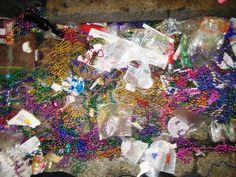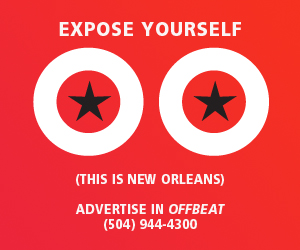 Mardi Gras is over, thank goodness. Here are a few curmudgeonly comments.
Mardi Gras is over, thank goodness. Here are a few curmudgeonly comments.
It’s fun to view the parades, appreciate the beauty of the costumes, laugh at the drunks, catch beads ‘n’ crap, dance to the marching bands and Mardi Gras music, visit with your neighbors, meet new people in the crowd. But. I have to tell you that Mardi Gras can be a royal pain in the ass.
People in New Orleans accept it, but I don’t know anyone who doesn’t bitch about it. Traffic is horrendous, and God help you if you make a wrong turn and get stuck in a queue that’s backed up because of a blocked-off street or a passing parade. That’s a big issue. It’s also a bit of a problem if you do business with anyone outside the city because—guess what? No one else knows that it’s Mardi Gras here (nor do they care). We just have to train our out-of-town contacts that New Orleanians don’t work on Mardi Gras Day. It’s the New Orleans “high holy day.”
I love the satirical parades; they’re usually well worth a viewing. One thing I don’t like is the Tucks Parade throwing of toilet paper rolls with their logos on each sheet of paper. Beads adorning the trees I don’t particularly mind; toilet paper I do. St. Charles Avenue looked like it got “rolled” after the Tucks Parade on Sunday. Yuck.
The meeting of several Mardi Gras Indian tribes still took place at Second and Dryades. Bo Dollis, Jr. and Laurita Dollis, Bo’s “Queen Rita” masked for the annual event, and a full-size cut-out of Bo graced the door of the Sportsman’s Lounge on the corner. I was there and noticed something that disturbed me. I wondered why so many cars disrupted the event. There were no street blockades or barricades to prevent automobiles from going through that intersection. It was pretty dangerous. Seems to me that it would show a lot of respect to the Mardi Gras Indians if the city could block off those streets. Is it because no one applies for a permit to do this? Or is it because the blockades only protect the krewes parading down St. Charles Avenue from traffic access? I didn’t see one policeman near the corner while I was there on Second and Dryades; I saw many on St. Charles Avenue. Seems like a bit of disparity in cultural traditions to me.
Finally, I do love watching the big parades, but I still have a bit of an issue with the “Mardi Gras mentality”: 1) men/women pay dues to join a private club; 2) from their dues, a large event is created to entertain the masses, but also to entertain the krewe members (trust me, the only reason Mardi Gras has persisted all these years is because the guys riding the floats are enjoying themselves a lot more than the peasants begging for beads on street); 3) krewe members spend massive dollars on creating a parade and to purchase junk that’s literally thrown away; 4) the city has to provide massive manpower to maintain the peace and to clean up the crap; 5) we’re told that the excess money made by the non-profit krewes supports charities. Which charities?
I’ve posted about this before: Mardi Gras krewes collect a substantial amount of money from their members (The Krewe of Endymion stated that their revenues in 2013 were nearly $6.7-million in 2013, with expenses amounting to almost $5.9-million, and net assets worth over $5.7-million). CityBusiness recently did a survey that gathered information on the top 10 krewes’ revenues and expenses (this is easily available because the krewes are incorporated as non-profit entities and their tax information, or Form 990, is readily available from soures like Guidestar.org). Think about how much money literally gets thrown into the dumpster post-Mardi Gras. Couldn’t we think of a different way for our privileged citizens to support charities in the city?
Each krewe considers that its benefit is that it throws a “free party” for the city, which also has an enormous economic impact on New Orleans’ businesses. In addition, many krewes say that they distribute funds back into the community in the form of grants or support for certain charities such as schools.
Yes, I enjoy Mardi Gras, but every time I see the crap on the streets post-parades, including the aforementioned toilet paper in trees, literal tons of plastic wrapping, beads and other junk that lands in the garbage (and has to be cleaned up by the city, at a cost, of course), I wonder if anyone has ever done a cost-benefit analysis of Mardi Gras to the City of New Orleans. I’m sure no one could possibly argue that Mardi Gras doesn’t improve our economy (particularly as related to the hospitality industry), but if Mardi Gras krewes are set up as non-profits why are some of the krewe’s net assets so large? Endymion’s, for example, are stated as $5.73-million.
Intensive Mardi Gras analysis is somewhat of a sacred cow (there are too many high-rolling businessmen and women in their ranks). God forbid that we find out that krewes are raking in more dough than they give back to New Orleans.
Let’s put it this way: Keeping our traditions is certainly important. Mardi Gras is a money-making machine that’s grown out of a homegrown tradition. I would like to see exactly where Mardi Gras krewes spend their money and how they donate back to charity, and what charities they support. I’ve thrown out the idea that the krewes should donate funds specifically to the music, arts and culture of the city. Where does their money go? How many concessions does the city offer to krewes for police protection, sanitation and the like. How much does Mardi Gras really cost us?




